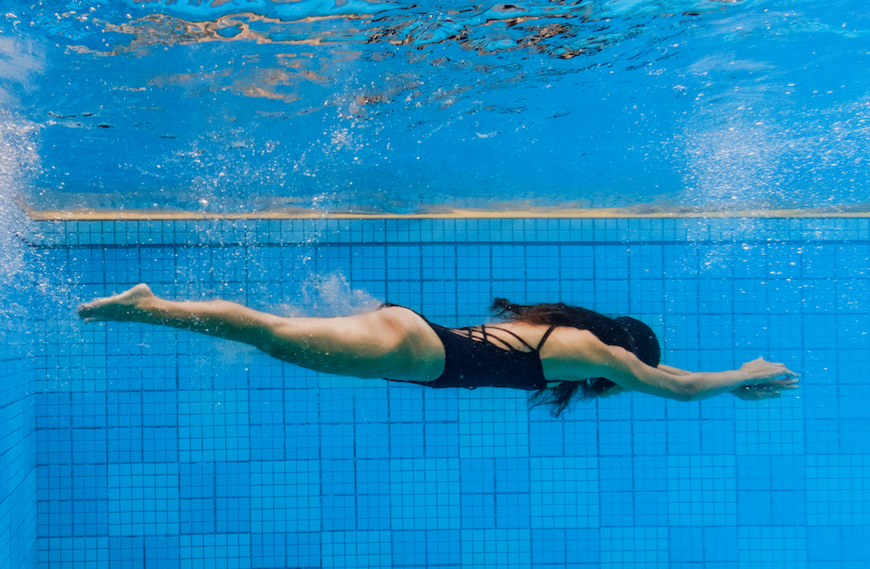
February 18, 2020 at 05:00PM by CWC
A few weeks ago, I did the weirdest thing of my life to date: I learned how to hold my breath under water. And no, it wasn’t the 30-second amateur stuff you master for youth swim meets—it was full minutes without oxygen. I’ll let that settle in.
If you’re wondering why a person outfitted with a perfectly healthy set of lungs would willingly deprive herself of air, there’s a very simple answer: I heard that some of the world’s foremost athletes do it for better performance. Freedivers hold their breath to plunge far beneath the ocean’s surface. Redbull athlete and free-surfer Jamie O’Brien uses breath-holding techniques until he can come back up for air during his most life-threatening wipeouts. And Olympic sprinters Joaquim Cruz and Mary Decker used a similar technique to boost their respiration in sprint races in the 1970s.
I myself am not a free-diver, nor a sprinter, nor a surfer, but I am endlessly curious about how the cogs of the body make or break athletic performance. And that’s how I found myself at New York City’s Aqua Studios, learning how to not breathe with Kirk Krack, a world-famous freediving trainer whose client roster includes soaking-wet versions of celebs like Margot Robbie and Tom Cruise.
Minutes into the session (which bless, started on dry land) I learned that holding your breath actually involves a lot of… breathing. Before you give up good old O2 for several minutes, Krack tells our group that you have to make sure your body’s chock-full of the stuff. To help us do just that, he tells us how to inhale and exhale… like we’re babies. “Breathing is so fundamental to our daily existence, yet we rarely give it a thought or understanding of how important it can be to us,” says Krack. “Our most efficient breathing was in our first years of being born when we were natural belly breathers—just watch a baby sleeping and see where its breathing comes from—and then over time, we learn bad breathing habits,” he says.
“Our most efficient breathing was in our first years of being born.” —Kirk Krack, world-famous freediving trainer
ADVERTISEMENT
ADVERTISEMENTKate Spade Autumn/Winter Sale |
As the hours of Krack’s workshop progressed, he showed our small group how to breathe into the depths of the diaphragm using a technique he called “ventilation breathing.” “Ventilation breaths are a diaphragmatic and lower chest volume of breaths that are really focused on the rhythm of the breathing being a 15-second total cycle of which 10 seconds is an exhalation,” says Krack. “This style helps effectively oxygenate the blood, but more importantly, it helps slow the heart’s overall metabolic rate and activates its oxygen-conserving mechanism.” Meaning, yes, your body starts to use oxygen more efficiently. And over time—with practice—it can teach you how to manage the fight or flight, cortisol response your body often has during strenuous exercise.
The instruction for ventilation breathing goes like this:
1. Sit in a comfortable position on the floor or a chair. (Do not practice when driving, because, duh.)
2. Open your mouth and breath into your diaphragm and lower chest for five full seconds.
3. Exhale through your mouth for 10 seconds while resting your teeth together and bringing your tongue to touch the top of your mouth so you hear a “shhh” sound.
4. Pause, repeat.
Five minutes of ventilation breathing left me feeling completely relaxed, almost like I’d just walked out of an hour-long yoga class (or slept…like a baby). But the next steps needed to hold your breath aren’t quite as relaxing. “Purging breaths,” which Krack guides us through next are meant to make it easier for your body to access oxygen when you submerge. If you’ve ever practiced Kundalini yoga’s “breath of fire”, it’s a similar technique to that, and basically involves snapping your diaphragm in using fast exhales.
Once they come up for air, freedivers and some surfers (like O’Brien) practice recovery breathing, too. But for the sake of your own athletic performance, Krack says you can stick to practicing the ventilation breathing daily. “If we just spend a quick 20 breaths daily, this can help us in a basic way to progress to better breathing habits and a healthier living,” says Krack. Yes, this includes better athletic performance—but knowing how to mitigate your body’s fight or flight response also means you can calm your racing mind before bed, or breathe your way through stressful situations.
Curious about aqua cycling? Here’s what it’s like:
Thinking about taking after an athlete and running a marathon? This training plan will get you started, and don’t forget to stretch it out.
Author Kells McPhillips | Well and Good
Selected by CWC
ADVERTISEMENT
ADVERTISEMENTSports Direct Free Delivery on All Orders! |

ADVERTISEMENT
ADVERTISEMENTUp to 30% off Gift Sets |







